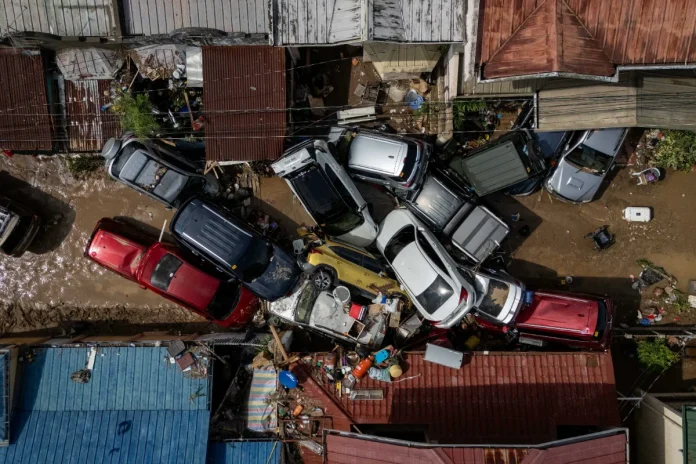Typhoon Kalmaegi kills over 100 in Philippines with unprecedented flooding in Cebu province, as officials investigate ghost flood-control projects.
CEBU: The death toll from Typhoon Kalmaegi in the central Philippines climbed past 100 on Wednesday as the devastating impact on Cebu province became clearer.
Floodwaters described as unprecedented rushed through the province’s towns and cities, sweeping away cars, riverside shanties and massive shipping containers.
Cebu spokesman Rhon Ramos told AFP that 35 bodies had been recovered from flooded areas of Liloan, bringing the toll for Cebu to 76.
On neighbouring Negros Island, at least 12 people died and 12 more were missing after Kalmaegi’s driving rain loosened volcanic mudflow which buried homes in Canlaon City.
Police Lieutenant Stephen Polinar explained that volcanic material deposited during last year’s eruptions rumbled down onto villages when the heavy rain fell.
The earlier government tally of 17 deaths outside Cebu included six crewmembers of a military helicopter that crashed during a typhoon relief mission.
AFP reporters spoke with residents of Cebu’s most-affected areas as they cleaned up streets that had been rivers a day before.
Reynaldo Vergara, 53, described how the water was so strong around four or five in the morning that you couldn’t even step outside.
“Nothing like this has ever happened. The water was raging,” he said, adding that everything in his small shop in Mandanaue had been lost when a nearby river overflowed.
In nearby Talisay, where an informal settlement along a riverbank was washed away, 26-year-old Regie Mallorca was already rebuilding his home.
“This will take time because I don’t have the money yet. It will take months,” he said as he mixed cement and sand atop the rubble.
The area around Cebu City was deluged with 183 millimetres of rain in the 24 hours before Kalmaegi’s landfall, well over its 131-millimetre monthly average.
Provincial governor Pamela Baricuatro called the situation “unprecedented” and “devastating” on Tuesday.
Scientists warn that storms are becoming more powerful due to human-driven climate change, with warmer oceans allowing typhoons to strengthen rapidly.
In total, nearly 800,000 people were moved from the typhoon’s path across the affected regions.
The catastrophic loss of life in Cebu comes as the public seethes over a scandal involving so-called ghost flood-control projects believed to have cost taxpayers billions.
Governor Baricuatro suggested a connection between the corruption scandal and what her spokesman later called “unusual” flooding in a cluster of subdivisions.
“You begin to ask the question why we’re having terrible flash floods here when you have Ph26.6 billion for flood control projects,” she said in an interview with local outlet ABS-CBN.
“Definitely we have seen projects here… that I would say are ghost projects,” she added, noting her inspection team had not seen a single structure built to government standards.
A spokesperson at the Department of Public Works and Highways said department head Vince Dizon was already in Cebu to inspect typhoon damage.
The Philippines is hit by an average of 20 storms and typhoons each year, routinely striking disaster-prone areas where millions live in poverty.
Weather specialist Charmagne Varilla said the country has already reached that average with Kalmaegi, adding at least “three to five more” storms could be expected by December’s end.
By 5 pm on Wednesday, Kalmaegi was moving westwards over the South China Sea towards Vietnam, where authorities warned it could compound existing flood damage. – AFP










